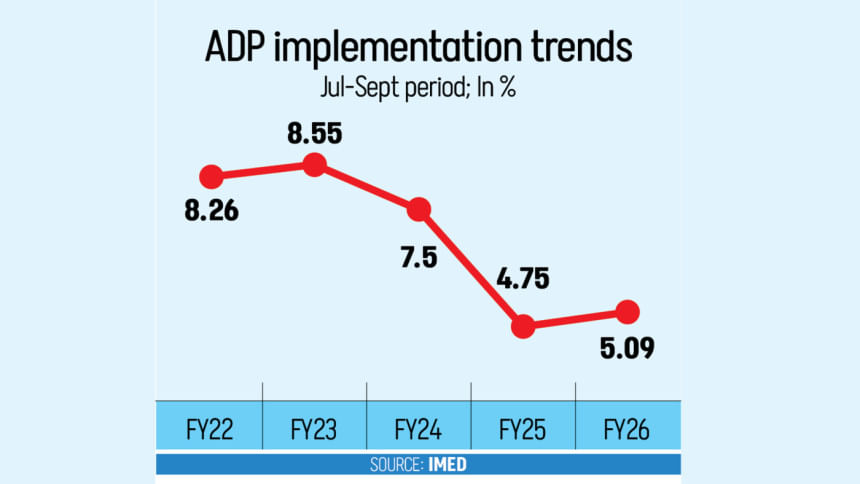ADP spending rises in Sept

Bangladesh's development expenditure under the Annual Development Programme (ADP) rose 6 percent year-on-year in September after the planning ministry laid emphasis on accelerating its implementation.According to the Implementation Monitoring and Evaluation Division (IMED), ADP spending reached Tk 6,443 crore last month, up from Tk 6,072 crore in the same period of the last fiscal year.In spite of the interim government's commitment to boost development outlays, execution has been slow.In July,...
Bangladesh's development expenditure under the Annual Development Programme (ADP) rose 6 percent year-on-year in September after the planning ministry laid emphasis on accelerating its implementation.
According to the Implementation Monitoring and Evaluation Division (IMED), ADP spending reached Tk 6,443 crore last month, up from Tk 6,072 crore in the same period of the last fiscal year.
In spite of the interim government's commitment to boost development outlays, execution has been slow.
In July, ADP implementation fell to nearly 50 percent, and August saw a similar decline.
In response, Planning Adviser Prof Wahiduddin Mahmud convened a meeting with senior officials across ministries and divisions, urging them to expedite project execution.
An IMED official said the adviser's intervention had led to a modest uptick in spending, but implementation has yet to return to normal levels.
In the first quarter of the current fiscal year, ADP implementation stood at Tk 12,158 crore, equivalent to 5.09 percent of the total allocation. This compares to Tk 13,215 crore, or 4.75 percent of the allocation, in the same period last year.
While the percentage of the allocation spent has increased, the overall amount declined due to lower disbursements in July and August.
Excluding the current and previous fiscal years, average first-quarter ADP implementation over the past five years has hovered around 8 percent.
Foreign aid utilisation continues to lag behind domestic funding.
In the first quarter, project loan spending amounted to Tk 5,074 crore, or 5.90 percent of the allocation, compared to Tk 5,360 crore, or 5.36 percent, last year.
Government-funded implementation reached Tk 6,307 crore, down from Tk 6,633 crore a year earlier.
Of the total ADP allocation of Tk 2,38,695 crore for FY2025-26, 75 percent is concentrated in 15 ministries and divisions.
Among them, the Ministry of Science and Technology leads in implementation, spending 18.14 percent of its allocation — driven largely by the Rooppur nuclear power plant, a priority project for the government.
The Energy and Mineral Resources Division recorded the second-highest implementation rate at 9.75 percent, followed by the Ministry of Water Resources at 7.84 percent and the Local Government Division at 7.81 percent.
The interim administration is focusing on rural economic revitalisation and employment generation through increased public investment in these sectors.
Despite being a high-priority area, the Ministry of Health continues to underperform in development spending.
The Medical Education and Family Welfare Division spent just Tk 1.57 crore, or 0.003 percent of its Tk 4,809 crore allocation, while the Health Services Division disbursed Tk 84 crore, or 1.13 percent of its Tk 7,484 crore allocation.
Economists have long called for increased health sector funding, but the ministry has consistently lagged behind in execution, a trend that persists under the current government.
Other underperforming government wings include the Ministry of Railways and the Bridges Division.